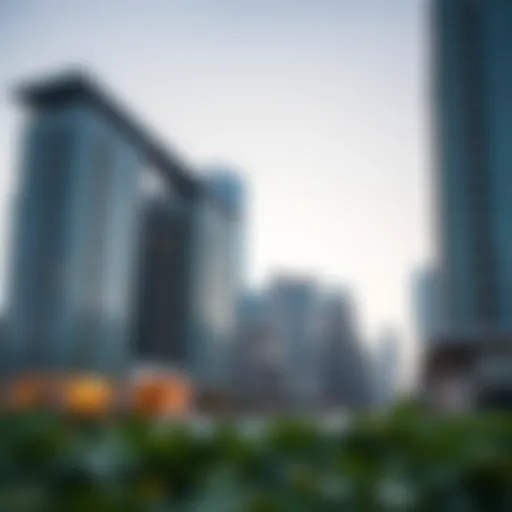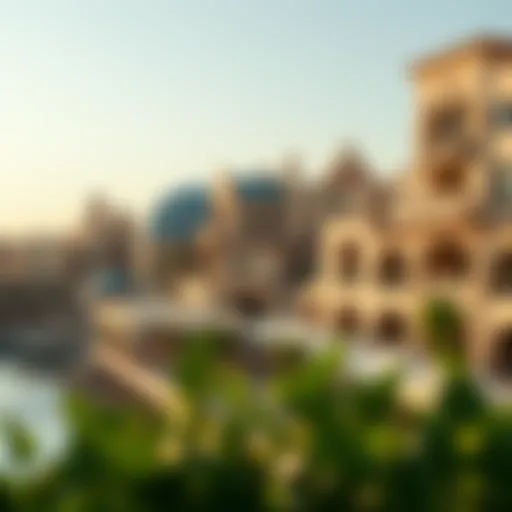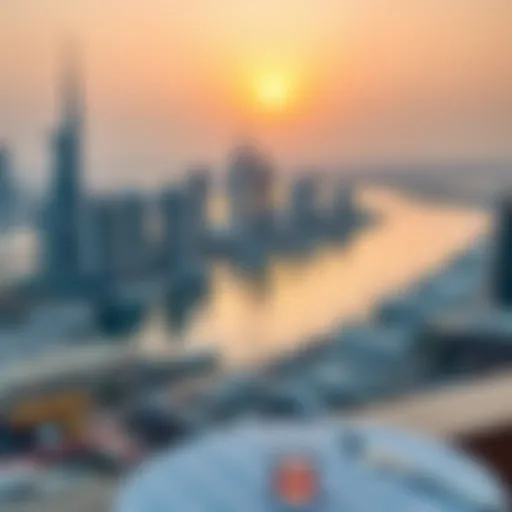Comparative Insights into Dubai and Abu Dhabi


Intro
Understanding the contrasts between Dubai and Abu Dhabi is no small feat, especially if you're looking to seek out the right opportunities or decide on where to plant your roots. Both cities, part of the United Arab Emirates, offer unique experiences and advantages. They share a lot, from their cultural heritage to their ambitious modernization efforts, yet they diverge in significant ways regarding their economies, lifestyles, and what each city represents.
Dubai often steals the limelight, known for its dazzling skyscrapers and vibrant lifestyle. In contrast, Abu Dhabi tends to maintain a quieter yet equally compelling atmosphere, often regarded as the political heart of the Emirates. This guide aims to peel back the layers of both cities, giving you not just surface-level insights, but a detailed view of the economic frameworks, cultural landscapes, and real estate variables that define them.
For investors, expatriates, or even those contemplating relocation, it’s crucial to grasp the distinctive characteristics that set these two cities apart. This exploration isn’t merely academic; it helps in making informed choices that could reshape one's livelihood. Each section that follows will provide clarity.
Let’s dive deeper and see what each city has to offer, starting first with Market Trends, which forms the backbone of any informed decision-making process.
Economic Overview of Dubai and Abu Dhabi
The economic landscape of Dubai and Abu Dhabi serves as the backbone of their identities, significantly influencing their development trajectories and shaping their futures. With distinct yet interconnected economic frameworks, these two metropolises in the United Arab Emirates offer invaluable insights for investors, expatriates, and anyone considering a move to the region. Understanding their economies helps individuals make informed decisions, whether it is regarding investment placements or personal relocations. The differing economic sectors and investment climates in each city highlight not only their unique advantages but also potential pitfalls.
Dominant Economic Sectors
Dubai: Tourism and Hospitality
Dubai is renowned for its glamour and allure, particularly in the tourism and hospitality sector. Visiting it feels like stepping into a modern fairy tale where luxury meets culture. This city has cultivated a reputation as a global hub for tourism, attracting millions every year. With landmarks like the Burj Khalifa, luxurious shopping malls, and vibrant nightlife, it stands out. The hospitality sector, involving thousands of hotels, restaurants, and entertainment options, plays a crucial role in driving economic growth. While the high-end market shines, Dubai also sees a healthy number of budget travelers, showcasing a diverse economic ecosystem in tourism.
However, the reliance on tourism bears its risks. Economic stability can swing with global events—be it a pandemic or economic downturn—which directly affects traveler numbers. Hence, sustaining growth while managing vulnerabilities remains a critical aspect of this sector.
Abu Dhabi: Oil and Gas Sector
Abu Dhabi’s economy, on the other hand, is heavily anchored in oil and gas. This sector has not only brought wealth to the emirate but also placed it on the geopolitical map. The city houses some of the largest oil reserves in the world. Revenue generated from this sector fuels government spending and shapes public services, ensuring a higher standard of living for its citizens and residents.
Nonetheless, heavy dependence on oil presents challenges, especially in the context of fluctuating oil prices and a global push toward renewable energy. As the world shifts towards sustainability, Abu Dhabi faces the critical task of diversifying its economy beyond hydrocarbons to ensure long-term stability.
Diversification Efforts in Both Cities
Both Dubai and Abu Dhabi recognize the necessity of diversification. Dubai’s proactive approach has seen it embrace innovation and technology, as well as a burgeoning financial sector. Initiatives such as the Dubai Internet City and Dubai Media City show their intent to reduce reliance on tourism alone. At the same time, Abu Dhabi is investing heavily in sectors like renewables and technology, indicated by massive projects such as Masdar City, aimed at developing sustainable urban areas.
These diversification efforts are not mere ambitions but essential strategies for long-term sustainability. By fostering various sectors, both cities are preparing themselves for a post-oil future, which is crucial for economic resilience and growth.
Investment Climate
Foreign Direct Investment Trends
The investment climate in both cities has seen significant Foreign Direct Investment (FDI) inflows owing to their strategic plans and openness to investors. Dubai’s free zones and investor-friendly regulations have established it as a premier destination for foreign capital, especially in sectors like technology and tourism. This influx not only boosts the economy but signifies global confidence in Dubai as a stable investment hub.
On the flipside, Abu Dhabi has also ramped up efforts to attract FDIs through initiatives such as its economic diversification strategy. However, it faces fierce competition from its neighbor, which sometimes overshadows these efforts. Striking the right balance between attracting investments and addressing local employment remains a challenge for Abu Dhabi.
Regulatory Framework
A clear and comprehensive regulatory framework defines the ease of doing business in both cities. Dubai has streamlined regulations to make it easier for entrepreneurs and businesses to set up shop. The Dubai Economic Department routinely updates its policies to keep pace with global trends, thereby reassuring investors.
Conversely, while Abu Dhabi has made significant progress in easing regulations, businesses still encounter more red tape relative to Dubai. Simplifying these processes could further stimulate economic growth and increase its attractiveness for foreign entities.
Incentives for Investors
Both cities offer a variety of incentives for investors, which is a substantial draw. In Dubai, the Investor Visa program and 100% foreign ownership in free zones facilitate foreign participation in businesses, making it highly appealing. This flexibility helps cater to a wide range of investors looking for new opportunities.
In Abu Dhabi, various incentives, including no income tax and competitive land leasing rates, are designed to lure businesses into its rapidly developing economic landscape. Still, investors need to be wary of potential bureaucratic hurdles that can impede efficiency.
To summarize, the economic overview of Dubai and Abu Dhabi paints contrasting yet complementary pictures. While Dubai shines with its tourism and innovation, Abu Dhabi excels through its oil wealth but is taking strides towards economic diversification. Understanding these dynamics lays the foundation for informed decisions in navigating the unique opportunities presented by each city.
Cultural Dynamics and Heritage


Understanding the cultural dynamics and heritage of Dubai and Abu Dhabi is essential when evaluating the unique characteristics of these cities. Both cities are not just economic powerhouses but are also bastions of rich traditions and diverse communities. This section will delve into the cultural institutions, social fabric, and how traditions resonate with the modern life of their inhabitants. Recognizing these components is critical for anyone looking to invest, relocate, or simply appreciate the contrasting identities that each city offers.
Cultural Institutions
Museums and Art Galleries in Dubai
Museums and art galleries in Dubai serve as a lens through which one can gauge the city’s evolution from a modest fishing village to a modern urban marvel. One standout feature is the Dubai Museum, located in the Al Fahidi Fort. It showcases the emirate's heritage and culture through a rich array of artifacts and exhibits that tell the story of its past. This deep connection to history attracts not just tourists but also potential investors interested in the cultural fabric of the city.
The art scene is ever-growing as well, with contemporary galleries like the Alserkal Avenue leading the way in showcasing local and international talent. The advantage here is that it fosters a creative environment, enhancing Dubai's image as a cultural hub. However, there’s a flip side—some say the art scene feels commodified, catering to an international audience while local voices sometimes get drowned out.
Cultural Heritage in Abu Dhabi
Abu Dhabi's cultural heritage significantly differs from Dubai’s more commercialized approach. Highlights include the Sheikh Zayed Grand Mosque, an architectural marvel that not only serves as a place of worship but also as a testament to the UAE’s commitment to cultural inclusivity. This edifice attracts millions of visitors annually and stands as a symbol of unity in diversity.
The city is also home to the forthcoming Louvre Abu Dhabi, a colossal project aimed at celebrating global culture. What sets Abu Dhabi apart is its effort to genuinely engage with culture, ensuring the voices of Emirati tradition resonate alongside global narratives. An advantage is the potential for economic growth through cultural tourism; however, the challenge lies in striking a balance between modernity and tradition, which can sometimes be a tightrope walk.
Events and Festivals
Events and festivals form the backbone of cultural expression in both cities, presenting an opportunity for locals and expatriates to engage and celebrate together. In Dubai, events like Art Dubai and the Dubai Jazz Festival highlight the city's push towards being an international cultural destination. These gatherings not only foster social interactions but also have significant economic implications, drawing tourists into local businesses.
In comparison, Abu Dhabi also offers a vibrant festival calendar, with initiatives like the Abu Dhabi Festival which showcases global arts and culture through performances and exhibitions. The uniqueness of such events lies in their ability to create a dialogue between cultures, enhancing mutual respect and understanding. However, there may be concerns about how these events adapt over time—staying relevant while remaining true to local heritage is a constant juggling act.
Social Fabric
Demographics and Expat Communities
The demographic landscape in both cities is marked by a significant expatriate presence, making the social fabric one of diversity and interplay. In Dubai, expatriates constitute nearly 90% of the population, forming vibrant communities that influence everything from cuisine to language. This melting pot is not just beneficial for cultural exchanges but also opens avenues for businesses to tap into varied consumer preferences.
Conversely, in Abu Dhabi, while expatriates still play a crucial role, Emiratis make up a more considerable percentage. This blend creates a unique dynamic where local traditions coexist with the influences of various cultures. An advantage here is the enriched community life, which can be a compelling factor for potential homeowners and investors. However, the challenge remains in navigating cultural sensitivities, ensuring that every community feels valued.
Traditional vs. Modern Cultural Expressions
The ongoing dialogue between tradition and modernity is crucial to both cities’ identities. In Dubai, the Burj Khalifa symbolizes modernity, standing in stark contrast to the traditional souks. While there are ongoing efforts to retain cultural expressions—like the revival of traditional crafts—it's often criticized that these efforts lack depth, mainly serving the tourism industry.
On the other hand, Abu Dhabi goes beyond the surface by integrating traditional cultural expressions into modern architecture and public spaces, such as the Qasr Al Watan. This fusion provides an authentic experience that encourages engagement with both local and expatriate populations. However, the potential pitfall can occur when commercial interests overshadow genuine cultural expression.
Integration Policies in the UAE
Integration policies in the UAE play a vital role in shaping the social fabric of both Dubai and Abu Dhabi. These policies are aimed at bringing together diverse communities while ensuring that Emirati culture is not overshadowed. Programs promoting dialogue and inclusion are becoming increasingly relevant, particularly as both cities attract a growing number of expatriates seeking opportunities.
The UAE government’s approach to inclusivity, such as initiating cultural exchange programs, reflects a commitment to this cause. The merits of such policies not only enhance social cohesion but also position the UAE as a progressive nation on the global stage. However, the effectiveness of such policies often hinges on their implementation—there are concerns regarding the actual impact on social integration versus the more superficial aspects often portrayed in media.
The cultural dynamics and heritage of Dubai and Abu Dhabi reveal that while both cities are modernized, their unique identities foster distinct opportunities and challenges worthy of exploration.
Real Estate Markets Compared
The real estate markets in Dubai and Abu Dhabi serve as a significant focal point for potential investors and expatriates seeking to establish a foothold in the UAE. Each city's real estate landscape reflects its unique economic strengths, population trends, and cultural contexts. Understanding the dynamics of these markets is not just a matter of curiosity; it plays a crucial role in informing investment strategies, personal relocations, and lifestyle choices.
Market Trends
Current Property Prices
Current property prices in Dubai and Abu Dhabi reveal a varied and layered landscape. As of 2023, Dubai remains a frontrunner in the luxury property market, with high demand driving prices up in key areas like Downtown Dubai and Dubai Marina. This trend underscores the appeal of cosmopolitan living, attracting affluent buyers from around the globe.
Conversely, Abu Dhabi has a more balanced property pricing structure. Residential properties are generally more affordable, making it an appealing choice for families and working professionals. The key characteristic here is the city's focus on providing options that cater to diverse income levels, from upscale villas to modest apartments.
The unique feature of current property prices is their ability to highlight the investment growth potential. Dubai, with its high returns on luxury rentals, can seem lucrative, but one must weigh this against the volatility often seen in its market. Meanwhile, Abu Dhabi offers stability and consistent rental yields, though potentially at a slower growth pace. Thus, knowing the current trends could dictate the choice between immediate luxury investment or a stable, long-term strategy.


Rental Market Overview
The rental market overview in these two cities paints a comprehensive picture. In Dubai, the rental market has exhibited a pattern of high turnover, often characterized by its short-term rental options that cater to tourists and expatriates seeking flexibility. This rapid pace of renting can be lucrative for landlords but may indicate a less stable tenant base.
On the other hand, Abu Dhabi's rental market leans toward long-term contracts, providing landlords with consistency and security. Here, rental prices have stabilized, fostering a more predictable environment for both tenants and property owners.
Moreover, the unique feature to notice is the growing demand for furnished apartments in both cities. This is particularly advantageous for expatriates, as it reduces the hassle associated with moving and settling down. However, it's important for investors to be aware that high rental prices in Dubai often come with burdensome service fees, impacting the net returns compared to the more straightforward setup in Abu Dhabi.
Emerging Areas for Development
Emerging areas for development in Dubai and Abu Dhabi reflect the cities' visions for future growth. In Dubai, neighborhoods like Dubai South and Dubai Creek Harbour are gaining traction, thanks largely to government backing and infrastructure investments. This characteristic is vital for investors, as early entry into these areas could yield substantial returns as they mature.
In Abu Dhabi, places like Al Reem Island and Saadiyat Island are captivating investors with their planned developments and cultural inclusivity. Investors are drawn to these areas for their promise of growth and integrated lifestyle offerings, combining residential, commercial, and leisure spaces.
A unique aspect of these emerging developments is their focus on sustainability and smart technology integration, appealing to environmentally conscious buyers. However, while the prospect seems bright, investors should still exercise caution; emerging areas often come with risks related to construction delays or shifts in market demand.
Investment Opportunities
Luxury Properties in Dubai
Luxury properties in Dubai represent a hallmark of opulence and architectural innovation. Primarily situated in areas like Palm Jumeirah and Dubai Marina, these properties boast cutting-edge designs and premium amenities. The key highlight of luxury real estate here is its ability to deliver high returns, making it an enticing choice for investors.
The draw of luxury properties goes beyond mere investment; they symbolize status and lifestyle. Owning a luxury property in Dubai is often seen as a gateway to an elite social circle, adding non-financial value to the experience.
However, potential buyers should be mindful of the market's volatile nature. Prices can fluctuate dramatically depending on global economic conditions, which could lead to eager investors facing challenges in the near future.
Affordable Housing Trends in Abu Dhabi
In recent years, affordable housing trends in Abu Dhabi have gained more attention. With initiatives aimed at reducing the cost of living and creating diverse neighborhood options, this segment has become increasingly accessible. A significant appeal is the government’s commitment to affordable housing projects, striving to cater to a wide range of residents—from young professionals to larger families.
This focus on affordable housing not only enables more residents to settle in the capital but also enhances community spirit. Potential investors might find this trend beneficial as it indicates stable demand from buyers and renters alike. However, the affordability factor may sometimes come with compromises in terms of luxury finishes or locations—something that prospective investors must consider.
New Developments and Their Potential
New developments in both cities showcase innovative designs and a forward-thinking approach that promises exciting opportunities. For instance, Dubai's Expo 2020 developments are setting the stage for commercial and residential growth, while Abu Dhabi's comprehensive master plans emphasize sustainability and family-friendly environments.
The key characteristic of these new developments is their blend of traditional Arabian culture with contemporary architectural trends, appealing to both investors and lifestyle enthusiasts. This unique feature enhances a sense of community while embracing modern living.
While these new ventures present compelling opportunities for early investment, they also come with uncertainty, like economic shifts that could delay completion timelines. Staying informed and performing due diligence is critical to making educated decisions in this evolving landscape.
In summary, the real estate markets in Dubai and Abu Dhabi offer diverse options ranging from luxury properties to affordable housing, each catering to different lifestyles and investment strategies. Understanding market trends, rental dynamics, and emerging developments is crucial when navigating these vibrant markets.
Lifestyle and Living Experience
The lifestyle and living experience in Dubai and Abu Dhabi encapsulates a world of contrasts and similarities that define the essence of living in these two cities. For investors, expatriates, and potential homeowners, understanding the nuances of daily life here is vital as it influences decisions related to financial investments, relocations, and ultimately, personal satisfaction. The urban infrastructure, quality of life, and community dynamics all come into play, significantly affecting how individuals view their living spaces.
Urban Infrastructure
Public Transportation Systems
Public transportation in both cities is an essential element contributing to their lifestyle. The Dubai Metro is particularly notable, offering a cost-effective way for residents to navigate the city. This system boasts modern, air-conditioned trains that run frequently, connecting to key areas such as the Dubai Mall and Dubai Marina. Abu Dhabi, while lagging slightly in extensive networks, has developed its own bus system that covers a significant area, aimed at resident comfort.
The beauty of these transportation systems lies not just in convenience but also in their sustainability. They are efficient, reducing pollution and often seen as a greener alternative to driving. Public buses in Abu Dhabi are equipped with modern facilities, making travel enjoyable. However, a downside might be the occasional overcrowding during peak hours, which can diminish the overall experience.
Connectivity and Accessibility
Connectivity in these two cities is second to none. Dubai’s extensive road networks, linkages to international airports, and access to major business hubs make it a preferred choice for many. Abu Dhabi, though traditionally more laid back, has seen rapid developments aiming to boost its connectivity. Major highways link the two cities seamlessly, allowing for easy commutes.


Yet, while connectivity is a point of pride, accessibility, particularly in certain newer developments, can be tricky. Some areas lack adequate pedestrian pathways or public transit options, creating barriers for residents. However, improving infrastructure is high on the agenda of local governments, indicating future advancements in accessibility.
Modern Amenities and Services
Both cities pride themselves on offering modern amenities and services that cater to both locals and expatriates. From high-end shopping malls, like The Dubai Mall, filled with global brands, to numerous healthcare facilities rated among the best, these cities excel in providing convenience. Abu Dhabi’s commitment to cultural spaces, such as the Louvre Abu Dhabi, showcases the desire to blend leisure with education.
For residents, having access to contemporary amenities means a higher quality of life. However, the cost can sometimes be restrictive, leading to discussions about affordability versus modern conveniences in daily living.
Quality of Life
Healthcare and Education
Healthcare and education systems in Dubai and Abu Dhabi reflect a blend of traditional values and modern expectations. Dubai offers a wide array of private healthcare options, complemented by well-equipped public facilities. The focus on high-quality education speaks volumes about the cities' goals to nurture the next generation. Various international schools provide diverse curriculums, attracting families from all walks of life.
However, rising costs of both healthcare and educational institutions can be a concern; families often grapple with budgets, as international-standard institutions carry a premium price tag.
Leisure and Entertainment Options
Leisure and entertainment choices in Dubai are practically limitless. Citizens and residents can enjoy world-famous attractions, concerts, cultural festivals, and vibrant nightlife. Abu Dhabi complements this lifestyle with a more relaxed approach, focusing on cultural events and family activities, like the annual Abu Dhabi Film Festival.
The unique aspect here is the balance between the exhilarating pace of life in Dubai, and the more laid-back yet culturally enriching experience in Abu Dhabi which caters to different preferences.
Community Engagement and Safety
Community engagement plays a significant role in enhancing the quality of life in both cities. Various initiatives foster interactions between nationals and expatriates, building a sense of belonging. The UAE authorities prioritize safety, with both cities ranking among the safest globally. This peace of mind, coupled with community programs, makes both Dubai and Abu Dhabi appealing places to live.
Nevertheless, cultural differences sometimes pose challenges in integrating some expat communities fully. Ongoing dialogues about inclusivity are essential in fostering a harmonious environment for everyone.
As we navigate through the complexities of urban living in Dubai and Abu Dhabi, one cannot ignore the refreshing blend of tradition and modernity that both cities offer, establishing them as prime locations in the Middle East.
Challenges and Opportunities
The economic landscape of both Dubai and Abu Dhabi is a tapestry woven from various threads of challenge and opportunity. Understanding these dynamics is crucial for investors, expatriates, and homeowners alike. The topics explored here not only shed light on existing hurdles but also illuminate pathways for future development and growth. Awareness of these factors assists decision-makers in devising strategies that align with their long-term goals, whether they seek investment returns or a new life chapter in the UAE.
Economic Challenges
Market Volatility
Market volatility remains a significant concern for stakeholders in the UAE. Changes in pricing, driven by both internal and external influences, can rapidly shift the market landscape. For instance, real estate prices can swing dramatically based on fluctuating economic indicators—like commodity prices or political stability in the region. The unique feature of market volatility here is its unpredictability, which can be both a curse and a blessing. On one hand, it provides opportunities for bargain hunters and savvy investors who can capitalize on dips. On the flip side, it instills caution among potential buyers and may deter new investments, creating a ripple effect in the broader economy.
Dependence on Specific Sectors
The economic fabric of both cities is heavily interwoven with certain sectors. For Dubai, tourism and trade are the lifeblood, while Abu Dhabi is largely defined by its oil and gas industry. This reliance on specific sectors poses risks, especially when market conditions fluctuate. The heavy investment in oil has made Abu Dhabi vulnerable to global market shifts and environmental concerns. Conversely, Dubai's dependence on tourism makes it susceptible to factors like global travel trends and economic downturns in key markets. Recognizing this characteristic of their economies is vital, as it underscores the need for diversification and innovation in their approach to economic growth.
Global Economic Influences
In an era of interconnected markets, global economic influences cast a long shadow on the fortunes of both Dubai and Abu Dhabi. Changes in international oil prices, economic policies from major economies, or even geopolitical tensions can send shockwaves through local markets. The key feature here is the externalities that can affect domestic conditions. For example, a downturn in a significant trading partner's economy can lessen demand for UAE exports, creating a challenging environment for local businesses. Hence, acknowledging these global influences helps stakeholders understand potential pitfalls and chart courses that hedge against external risks.
Future Opportunities
Sustainable Development Goals
Sustainable development practices are not just trendy buzzwords in today’s economy; they are essential for the future viability of Dubai and Abu Dhabi. By focusing on the United Nations' Sustainable Development Goals, both cities are aiming for a green future. This shift presents a unique opportunity for investors and businesses willing to invest in eco-friendly technologies and practices. Moreover, promoting sustainability can attract a discerning clientele that values corporate responsibility, thus expanding market share. Although the transition may present initial costs, the long-term benefits—like increased efficiency and brand loyalty—can outweigh these outlays.
Technology and Innovation
A strong emphasis on technology and innovation is rapidly reshaping both cities. Investing significantly in tech sectors positions them as leaders in digital transformation, thus broadening the economic base. Initiatives like the Dubai Internet City and Abu Dhabi's Hub71 showcase their dedication to fostering innovation. This approach can attract tech-savvy expatriates and purposeful companies eager to leverage cutting-edge solutions. However, a potential downside lies in the fast-paced nature of technology; businesses may find it challenging to keep up with rapid advancements without proper agility in management.
Tourism Growth Strategies
Tourism remains a cornerstone of the UAE’s economy, and both cities are devising strategies to bolster this sector. Projects such as Dubai's Expo 2020 and Abu Dhabi's Saadiyat Island aim to lure global visitors and enhance cultural engagement. Diversifying tourism offerings—like focusing on sustainable travel experiences or promoting lesser-known attractions—can give both cities an edge in a competitive market. However, the challenge remains in balancing tourism growth without compromising local communities' quality of life. Fostering genuine connections between visitors and residents is essential for creating sustainable and meaningful tourism experiences.
The combined efforts in addressing challenges and harnessing future opportunities will be pivotal in shaping the economic landscape of Dubai and Abu Dhabi, appealing to investors and expatriates alike.











